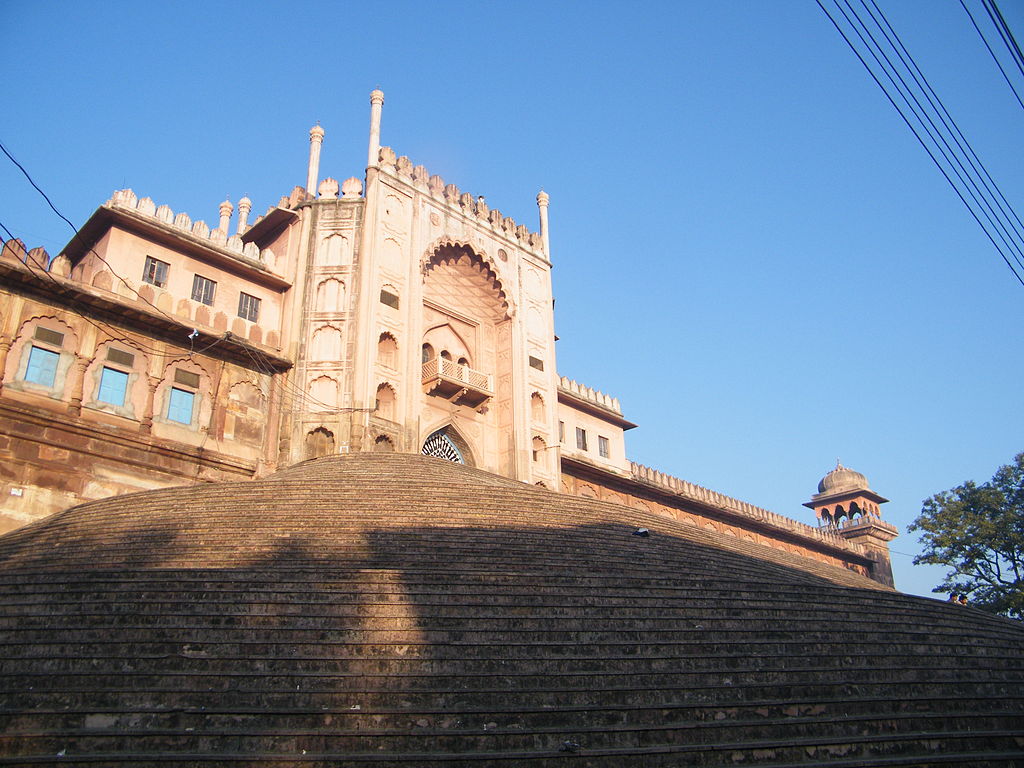
The Taj-ul-Masajid is a mosque situated in Bhopal, Madhya Pradesh, India. It is the largest mosque in India and one of the largest mosques in Asia. Nawab Shah Jahan Begum of Bhopal commissioned its construction in the newly-built walled suburb of Shahjahanabad. The exact year of construction is unclear. After Shah Jahan Begum died in 1901, the mosque continued to be built by her daughter Sultan Jahan Begum till the end of her lifetime. The structure is in the middle of three ponds. They are: Munshi Hussain Talab; Noor Mahal Talab; and Motia Talab. The mosque construction got delayed due to a lack of funds. After a long lay-off after the War of 1857, construction resumed, and In 1971 Allama Mohammad Imran Khan Nadwi Azhari and Maulana Sayed Hashmat Ali Sahab of Bhopal commissioned its building. The construction was completed by 1985. The entrance (eastern) gate was renovated grandly using ancient motifs from circa 1250 Syrian mosques by the contribution of the Emir of Kuwait to commemorate the memory of his departed wife. The Taj-ul-Masajid primarily takes inspiration from Mughal architecture. The mosque has a pink facade topped by two 18-story high octagonal minarets with marble domes, an impressive main hallway with attractive pillars, and marble flooring resembling the likes of Jama Masjid in Delhi and the Badshahi Mosque of Lahore. It has a courtyard with a large ablution tank in the center. It has a double-storeyed gateway with four recessed archways and nine cusped multifold openings in the main prayer hall. The massive pillars in the hall hold 27 ceilings through squinted arches, of which 16 ceilings are decorated with ornate petalled designs. The mosque also features a zenana (women's gallery), rare given that prayer from home was the norm for women at the mosque's construction.The Taj-ul-Masajid is a mosque situated in Bhopal, Madhya Pradesh, India. It is the largest mosque in India and one of the largest mosques in Asia. Nawab Shah Jahan Begum of Bhopal commissioned its construction in the newly-built walled suburb of Shahjahanabad. The exact year of construction is unclear. After Shah Jahan Begum died in 1901, the mosque continued to be built by her daughter Sultan Jahan Begum till the end of her lifetime. The structure is in the middle of three ponds. They are: Munshi Hussain Talab; Noor Mahal Talab; and Motia Talab. The mosque construction got delayed due to a lack of funds. After a long lay-off after the War of 1857, construction resumed, and In 1971 Allama Mohammad Imran Khan Nadwi Azhari and Maulana Sayed Hashmat Ali Sahab of Bhopal commissioned its building. The construction was completed by 1985. The entrance (eastern) gate was renovated grandly using ancient motifs from circa 1250 Syrian mosques by the contribution of the Emir of Kuwait to commemorate the memory of his departed wife. The Taj-ul-Masajid primarily takes inspiration from Mughal architecture. The mosque has a pink facade topped by two 18-story high octagonal minarets with marble domes, an impressive main hallway with attractive pillars, and marble flooring resembling the likes of Jama Masjid in Delhi and the Badshahi Mosque of Lahore. It has a courtyard with a large ablution tank in the center. It has a double-storeyed gateway with four recessed archways and nine cusped multifold openings in the main prayer hall. The massive pillars in the hall hold 27 ceilings through squinted arches, of which 16 ceilings are decorated with ornate petalled designs. The mosque also features a zenana (women's gallery), rare given that prayer from home was the norm for women at the mosque's construction.